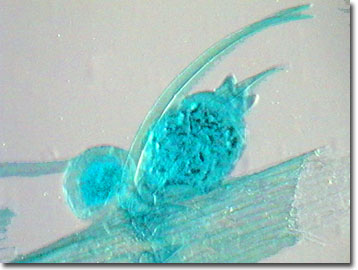Oblique Digital Image Gallery
Chara (Muskgrass)
The aquatic plants of the genus Chara are best known for the calcium carbonate deposits found along their nodes. Derived from the Greek meaning "joy", this invasive plant, also known as muskgrass, does little to live up to its name and to many, is considered a nuisance or weed.

View a second image of Chara.
Although its size and complex structure may be indicative of higher, flowering plants, Chara is actually a genus of multicellular macroalgae. Aptly nicknamed muskgrass because of its strong, garlic-like odor, this macroalga does not possess true leaves, but rather branches and branchlets. Instead of producing the fruits and seeds featured by higher plants, Chara forms dark, ball-like sporangia during times of reproduction. Charaphytes thrive as fast-growing aquatic plants in relatively deep water with low light intensities, particularly in high pH conditions.
In the bottoms of ponds, lakes, rivers, and ditches, Chara grows usually in thick beds, forming underwater meadows. Muskgrass is an unpalatable plant to crayfish, herbivorous minnows, and ducks and is also avoided by grass carp. Ecologically, Chara provides crucial escape cover for young fishes and aquatic invertebrates and serves as a stable structure for aquatic snails and predatory dragonfly larvae. In water bodies with fine sediments, the macroalgae provides a bottom cover that tends to reduce turbidity. In the absence of herbivores and with over-enrichment due to contaminated stormwater runoff, Chara beds may become a nuisance. They can choke waterways with plants that irritate swimmers and foul the propellers of recreational boats and may require aquatic herbicides and mechanical removal.
Contributing Authors
Cynthia D. Kelly, Thomas J. Fellers and Michael W. Davidson - National High Magnetic Field Laboratory, 1800 East Paul Dirac Dr., The Florida State University, Tallahassee, Florida, 32310.
BACK TO THE OBLIQUE IMAGE GALLERY
BACK TO THE DIGITAL IMAGE GALLERIES
Questions or comments? Send us an email.
© 1995-2025 by Michael W. Davidson and The Florida State University. All Rights Reserved. No images, graphics, software, scripts, or applets may be reproduced or used in any manner without permission from the copyright holders. Use of this website means you agree to all of the Legal Terms and Conditions set forth by the owners.
This website is maintained by our
Graphics & Web Programming Team
in collaboration with Optical Microscopy at the
National High Magnetic Field Laboratory.
Last Modification Friday, Nov 13, 2015 at 01:19 PM
Access Count Since September 17, 2002: 9024
Visit the website of our partner in introductory microscopy education:
|
|
